Day 1 of a two day Private Tour arranged in North Norfolk to coincide with a Wader Spectacular. It was a lovely bright & sunny day, with blue skies, hitting the heady heights of 25C in the afternoon. With a big high tide this morning, we were heading up to Snettisham to see the flocks waders today.
We could see large flocks of waders swirling around over the Wash already as we made our way out. When we got up onto the seawall, the tide was still out, which meant we had a bit more time today, so we stopped to scan. A large mass of Oystercatchers and godwits was gathered on the mud up by the sailing club, a mixture of Bar-tailed & Black-tailed Godwits. Lots of Shelduck were bobbing about on the water just offshore.
More smaller waders were still feeding busily on the mud across the channel. A Curlew Sandpiper flew across, identifiable by its white rump, and when it landed we got it in the scope. There were lots of Dunlin and Ringed Plovers out here too. We found a Spotted Redshank in a muddy pool – we could see its long, needle-fine bill when it lifted its head from feeding. Two Knot flew and landed close in on the beach just below the bank.
Four Swallows flew past low over the near edge of the mud. They were on their way south, migrants heading off on the long journey to Africa for the winter, a reminder that the seasons are changing.
The tide was coming in fast now, and the waders started peeling off the mud to the north of us, lines of Oystercatchers and godwits flying past, landing again on the mud further up.

We made our way down further and stopped again in front of Rotary Hide. The waders were now spread out like a vast slick on the mud, tens of thousands of Knot (there were 68,000 here at the last count, last week) and thousands of Oystercatchers (over 6,000 last week).
The Oystercatchers were walking away from the rising tide, the ones caught by the water marching through others which were still standing on dry mud, so the whole flock seemed to be moving across the mud like an amorphous blob.
The Knot were very jumpy, and kept flying up, whirling round low over the mud, before resettling. A young Marsh Harrier drifted across from the saltmarsh and out over the flocks, putting everything up. Instant chaos! We watched the Knot twisting and turning in unison, flashing alternately dark and light in the morning sunshine, making different shapes in the sky.
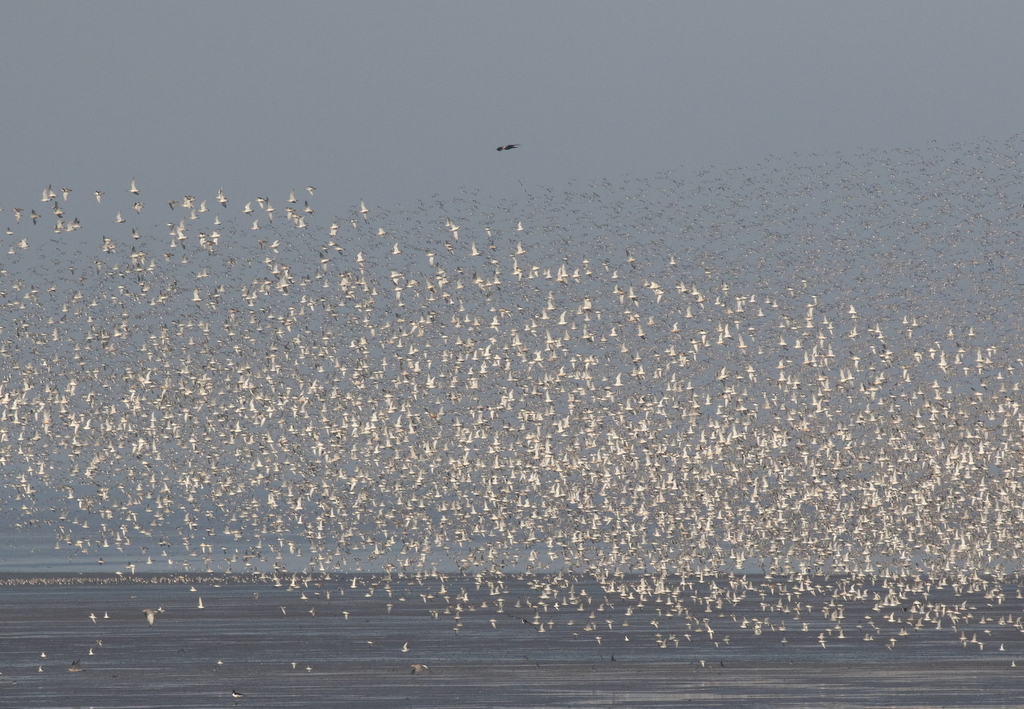

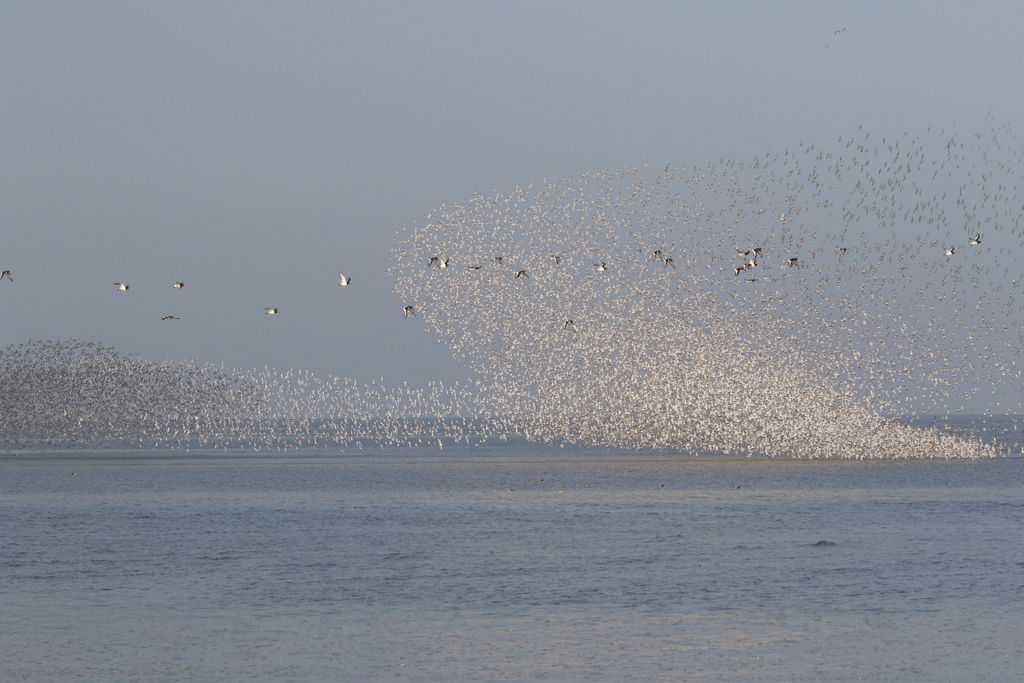
Further back, a Peregrine was putting up all the Knot up in the next bay over too. They looked like clouds of grey smoke in the sky. Most of them flew over and joined the flocks already gathered closer to us.
Continuing down to the grassy bank at the end of the path, the tide was still coming in fast. The waders were all increasingly concentrated in the last remaining corner of mud which was not covered by water.
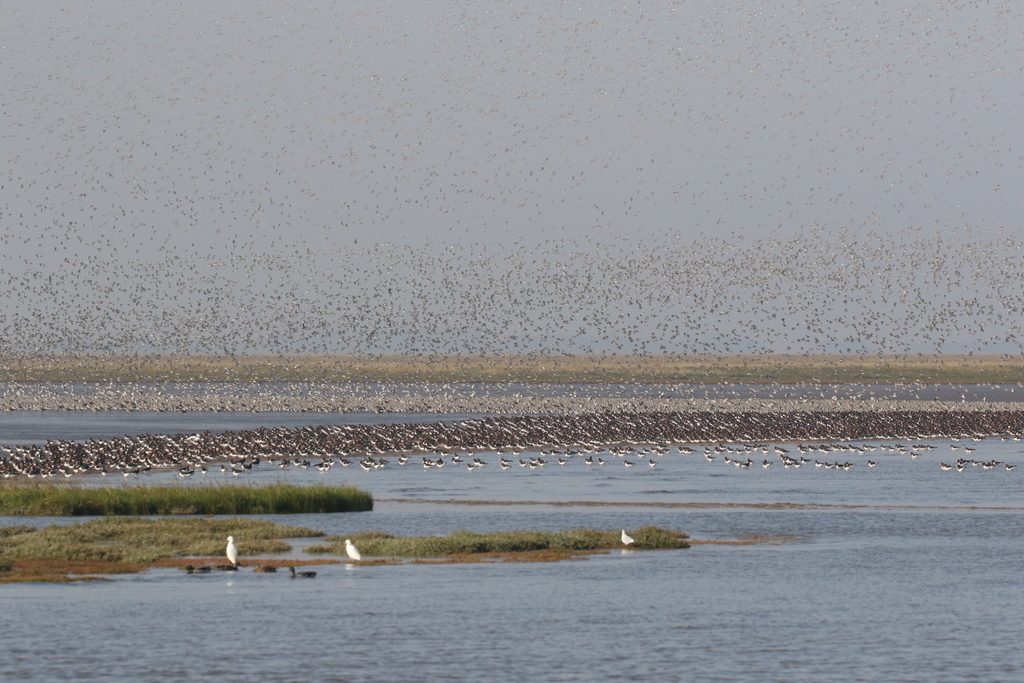
As usual, the Oystercatchers gave up first, peeling off in waves and flying in past us. Then suddenly all Knot went up. It was spectacular watching the tens of thousands of birds take to the sky. Some flew in overhead, towards the pit behind us, while others towered up into the sky above.
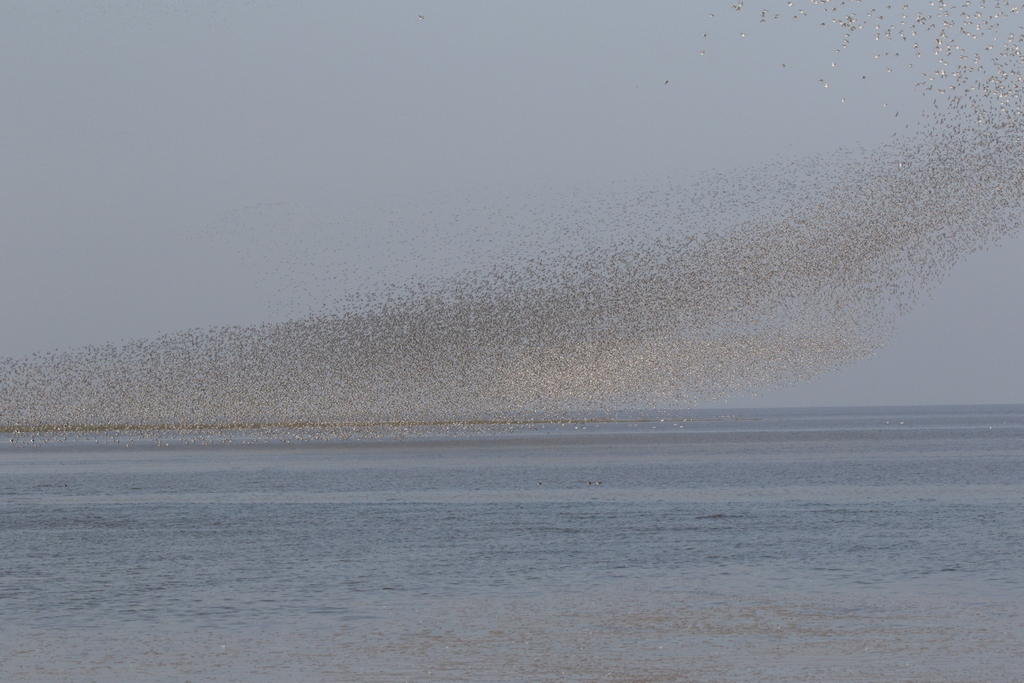
There was not much left out on the Wash now, just the Curlews in the corner by the saltmarsh, where they would stay to roost. The Knot were starting to drop down to the pit, so we made our way quickly round to South Hide. Relative few Knot had come in yet. There were some on the bank with the Oystercatchers, shuffling nervously, and the island at the bottom of the bank was full. A Common Sandpiper was feeding in the vegetation on the bank in front of them.
There were no Knot at all on the islands in front of the new hide, ‘Knots Landing’ (or ‘not landing’ again today!). There were lots of large lenses poking out of the camera windows and it didn’t help that one photographer had his lens out of the top window with his leg sticking out of the lower level one, waving around! But there was also shooting on the fields inland today, which kept spooking all the Greylags and probably didn’t help encourage the waders to settle.
More Knot started to drop in to join the others on the bank. We could see a large flock high over the pit, with a thick wispy line of birds dropping from it like a thread as they seemed to come down in an orderly queue. But many of the Knot already on the bank kept taking off again and flying round, which meant most of the flock never came in. They were just too nervous today and wouldn’t settle properly.
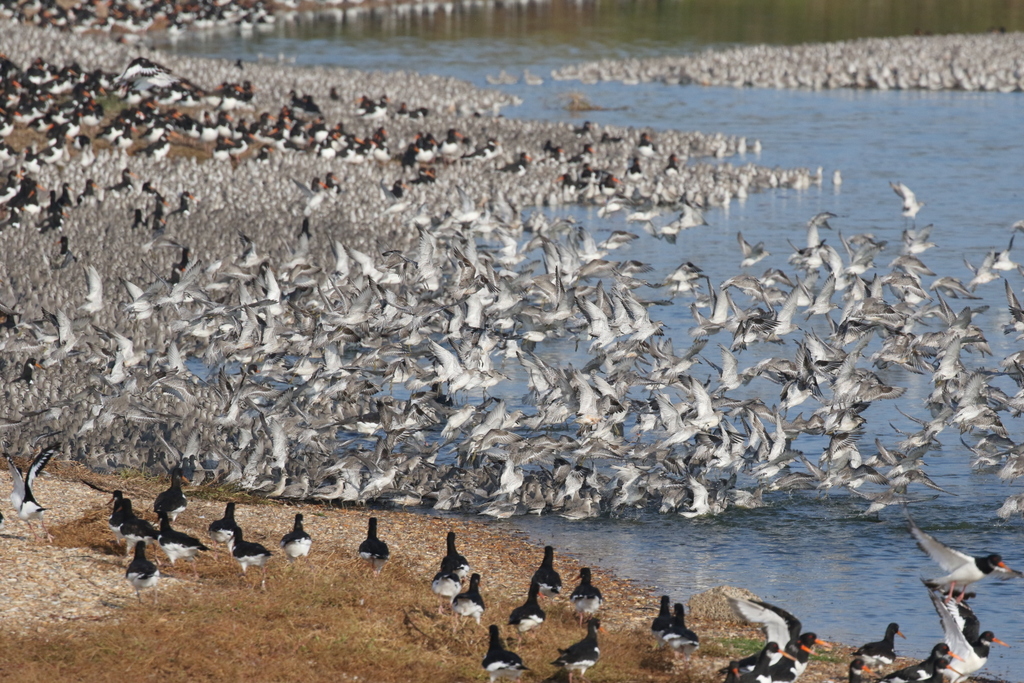
We looked back out towards the Wash and we could see that most of the Knot were still out there, whirling round over the water. We went back out of the hide, back to the bank to watch.
A small flock of Siskins came across in front of us, low over the saltmarsh, and we heard a Redpoll calling overhead too. More migrants, this time probably arriving here for the winter. A Chiffchaff started calling and came up out of the suaeda. A flock of Meadow Pipits on the grass behind had also probably dropped in on their way south.
Lots of Knot were flying back and forth low out over the Wash, looking for somewhere to resettle. Thousands more were still high in the sky above. There was a small curl of mud or shallow water still just beyond the edge of the saltmarsh, and some of the birds dropped down to land here. They were nervous though, and kept flying up and round, twisting and turning again.
Something disturbed many of the Knot and Oystercatchers from the pit behind us – they all took off and flew back out to the Wash in a thick line. Added to the others, they stirred everything up again, and everything whirled round again.
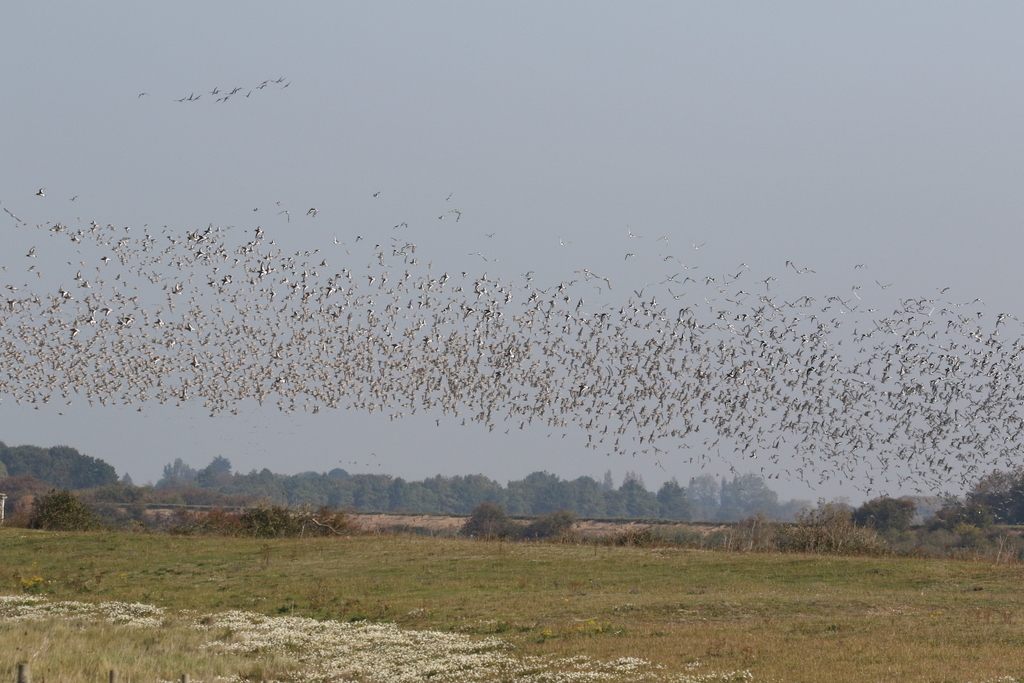

Eventually more of the birds started to settle out on the margin of the Wash, as the tide started to recede and more mud appeared. Lots of the Knot were now further out, round in the next bay. A Peregrine was still stirring them up, putting up huge clouds.
We decided to have a quick look in Shore Hide. As we walked up, we flushed a young Wheatear ahead of us from the path. It landed on the short grass, but was flushed again by someone who walked past in front of us as we were watching it in the scope. It landed again on the open area closer to the hide, close to the path, and proved to be remarkably tame, letting us walk right past it. Another migrant, stopping off on its way south.

There were not many waders on the pit now. Some Dunlin on one of the islands towards the north end, but we couldn’t find anything different in with them, lots of Common Redshanks, and still some Knot and Oystercatchers on the bank to the south. There were several Spotted Redshanks roosting out on the concrete blocks in middle – one was awake and we got a good look at it through the scope.
A young Peregrine came in, low over the pit, flushing everything. All the Common Redshank flew up, and the Peregrine headed straight into the middle of them, right in front of the hide. It stalled, and didn’t seem to know what to do next, which one to go for, at which point it had missed its opportunity.
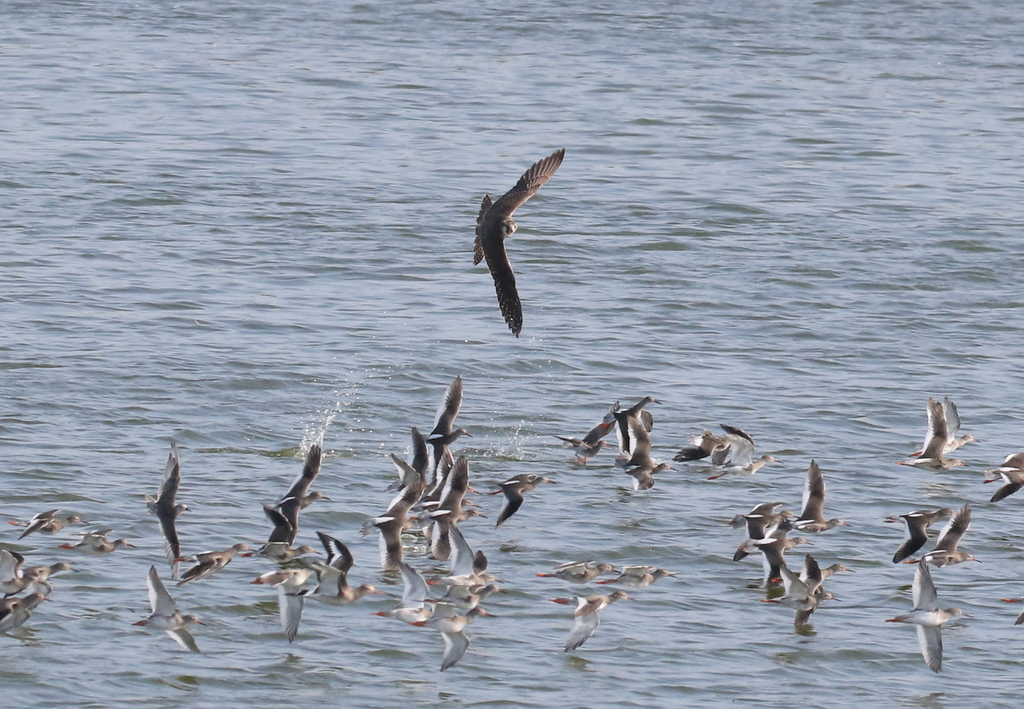
The Peregrine then flew over to the bank at the southern end of pit. The remaining Knot started to flush in a panic, and the Peregrine disappeared into their midst. Did it land? We couldn’t see exactly what happened in the ensuing melee, but somehow it managed to grab a Knot and came up with it in its talons. It was struggling to carry it – presumably the Knot was still alive because we could see the Peregrine still pecking at it as it flew up and away over the new hide.
That was quite a show! We headed back out to the edge of the Wash, where the waders were settled again now. Another wave of Knot came up from the pit, remarkable there was anything still on there after the Peregrine had been through. They flew in a long line over our heads, and low out across Wash.

There was lots of exposed wet mud now, and the waders were all spread out across the Wash. We scanned through some of the closer flocks, and found lots of pale silvery grey Sanderling with them now. Presumably they had roosted up along the beach again. The flocks would shuffle occasionally, fly up and round, a quick twist and turn, and then resettle closer to the waters edge. But in the absence of another visit from the Peregrine, the best of the show was over. We decided to make our way back.
As we walked along the path towards Rotary Hide, we could see a couple of people pointing their lenses down at something in the vegetation on the beach. We walked over and could see they were looking at a young Knot just a few metres from them. We had seen one with a broken wing on the rising tide out on the mud near here earlier, so we initially presumed this would be the same bird. But as we got closer we could see it looked fit and well, perhaps just a tame bird arrived from Arctic Greenland having never seen a human before.
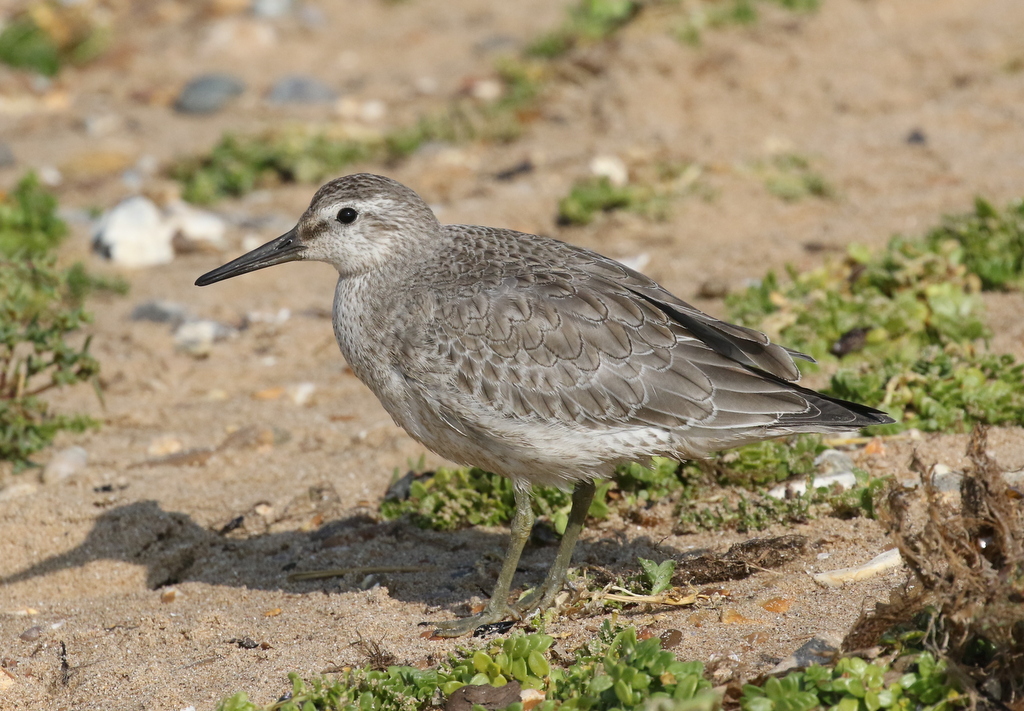
When we got to the main road, we found a massive tailback again, all the way from the Heacham traffic lights – unbelievably busy for a weekday in late September! It was a gloriously sunny day now though. We had to take a diversion inland again, and round to Titchwell. With the numbers of people obviously heading to the beach today, it was perhaps no surprise that the car park at Titchwell, still partly closed as an attempted Covid restriction, was full.
We were waved past, not even allowed to pull up. Apparently the car park had been full since early this morning, probably beachgoers again enjoying the nice weather on the sand and clogging up the restricted parking for the day, meaning people wanting to actually visit the reserve can’t even get in! It is not often you end up hoping for the weather to deteriorate!
We headed back round to Thornham Harbour for lunch. While we ate, we scanned the saltmarsh. We could see a large flock of Golden Plover in the vegetation and a group of Brent Geese on the beach beyond. More importantly we could see several people out at Thornham Point, across the Titchwell side of the harbour, clearly not seeing any Lapland Buntings. They had been on the beach this morning, but had obviously been disturbed. That was one of our main targets for Titchwell this afternoon, so we decided to head elsewhere.
The Brown Shrike had been reported early this morning still at Warham Greens by one person, but not seen by anyone since. We decided to head over that way to see if it might reappear.
We stopped at Wells. There were lots of geese on the big pool east of the track, mainly Greylags and Canadas, but scanning through we found two Barnacle Geese with them. Presumably feral birds from Holkham, where they breed, but nice to see anyway. There were plenty of ducks too, Wigeon and Teal, a few Shoveler, and we picked out a single Pintail.
The pools have been drying up fast in the recent warm weather, and there were not so many waders on here now, a few Black-tailed Godwits and Ruff on the larger pool to the east. The pool on the west side is now dry, but as we walked down the track, we found a single Common Snipe on the mud by the channel on the far edge.
As we walked in through the bushes beyond, they were rather quiet at first, although it was the heat of the afternoon now. In the hawthorns over by the seawall, we found a mixed flock of finches, mainly Goldfinches and Linnets. Several Wall butterflies came up out of the grass, and we watched a pair chasing each other, displaying.
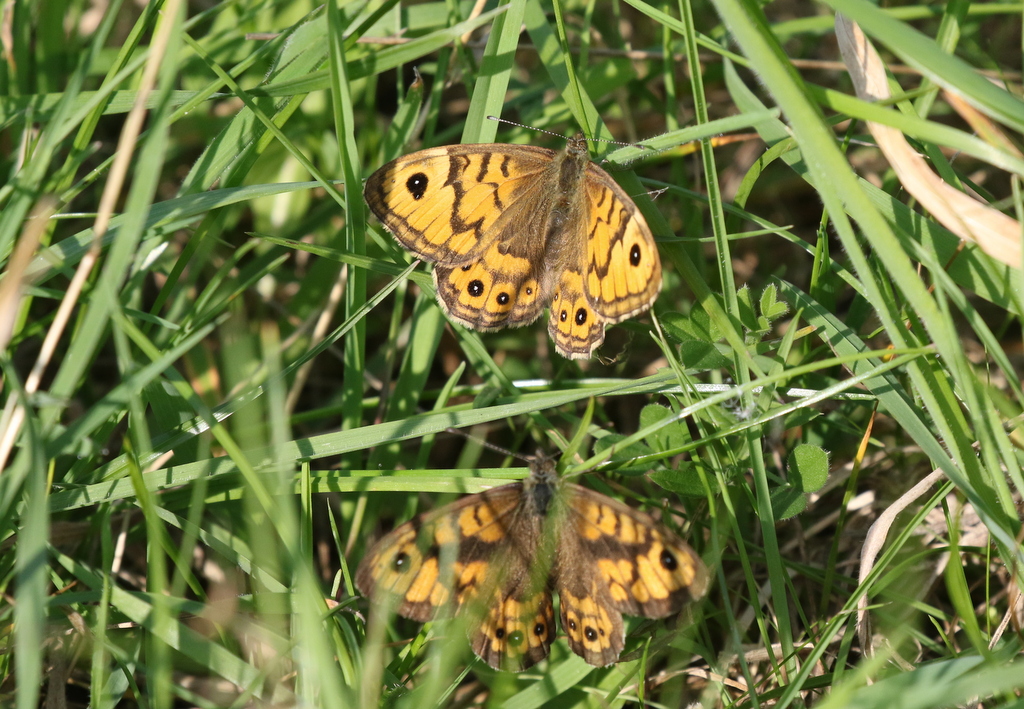
From up on the seawall, we had a look at the Western pool but couldn’t see anything of note. Looking out over the saltmarsh the other side, we could see a distant Red Kite and a Marsh Harrier over the dunes out towards the beach beyond.
We followed the coastal path east. As we walked through the small copse, there were lots of Ivy Bees on the flowering ivy in the sunshine. A fairly recent colonist here, they seem to be doing very well not and numbers are steadily increasing. Out of the copse, a flock of Long-tailed Tits came down along the hedge. We watched as they all passed us, but couldn’t see anything unusual with them. A Blackcap called from deep in the brambles. As we moved on, three Swallows flew west along the hedge, more migrants heading off on their long journey.
We walked down to where the Brown Shrike had been for the last few days, but we were told by people leaving as we arrived that it still hadn’t been seen again. We checked round the area where it had been favouring and found a Redstart up along the first hedge, flicking in and out down to the mown margin of the field, looking for insects. We managed to get it in the scope, but we were looking into the sun.
Three Grey Partridge, flew up from the edge of the field and we could see a single Red-legged Partridge much further up. We tried the hedge where we had seen the shrike the other day, but all we found here was another Redstart. The light was behind us now, so it was a better view of this one. We could see the flash of its red tail as it flew in and out ahead of us.

It was lovely being out in the sunshine, and very warm now out of the wind, but after an early start this mornign, we decided it was time to head back. We figured we would have another chance tomorrow if the shrike did reappear later, but it was never seen again so it was the right call. There would be lots of other good things to see tomorrow though.
















